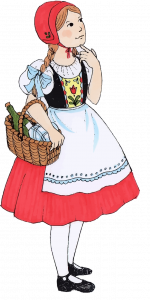Personalpronomen im Dativ – Personal pronouns in the Dative case
Just like in English, personal pronouns in German are used to replace nouns once they have already been mentioned, including people, animals, objects, or abstract ideas. You have already learned about these pronouns in the nominative case (subject of a sentence) and the accusative case (direct object of a sentence). Now you can learn about them when they are the indirect object of a sentence, the object of the prepositions aus, außer, bei, mit, nach, seit, von and zu or the object of a dative verb.
![]() Indirect Objects
Indirect Objects
Just like nouns that are the indirect objects of a sentence or a phrase, pronouns also change from the nominative to the dative case.
| Rotkäppchens Mutter | Rotkäppchen, deine Großmutter ist sehr krank. Kannst du ihr eine Flasche Wein und ein bisschen Brot bringen? | Little Red Riding Hood, your grandmother is very sick. Can you bring her a bottle of wine and a little bread? |
| Rotkäppchen | Ja, gerne. Kannst du mir bitte den kleinen Korb herüberreichen? Dann kann ich auch einige Blumen pflücken. | Yes, with pleasure. Can you please hand me the small basket? Then I can also pick some flowers. |
| Rotkäppchens Mutter | Rotkäppchen, was habe ich dir schon tausendmal gesagt? Erstens ist die Großmutter allergisch gegen Blumen, und zweitens ist das sehr schädlich für die Umwelt! | Little Red Riding Hood, what have I told you a thousand times already? First of all, grandmother is allergic to flowers, and second, this is very harmful for the environment! |

| Pronouns in the dative case | Singular | Plural |
| 1st person | mir (me) | uns (us) |
| 2nd person | dir (you) | euch (y’all) |
| 3rd person masculine | ihm (him) | |
| 3rd person feminine | ihr (her) | ihnen (them) |
| 3rd person neuter | ihm (it) | |
| formal | Ihnen (you) | |
![]() Objects of dative prepositions
Objects of dative prepositions
The dative case is used not only when the noun or pronoun is the indirect object of a sentence or a clause, but also when it follows certain prepositions: aus, außer, bei, mit, nach, seit, von and zu. There are also a handful of prepositions – called two-way prepositions or Wechselpräpositionen – that sometimes take the dative case; these are dealt with in a separate section.
| der Schüler | Guten Tag, Herr Meier! Wie geht es Ihnen? Kann ich mit Ihnen sprechen? | |
| Herr Meier | Leider kann ich nicht! Meine Frau ist krank, jetzt muss ich schnell zu ihr gehen. | |
| der Schüler | Das tut mir leid. Gute Besserung! |
![]() Objects of dative verbs
Objects of dative verbs
Dative pronouns, just like nouns in the dative case, are also used when they are in combination with dative verbs and verb phrases, such as helfen, glauben, folgen, weh tun, leid tun, for example.
| die Mutter | Mein liebes Kind, ich danke dir, dass du mir hilfst. | |
| das Kind | Nichts zu danken, Mama, gern geschehen. Wo ist Papa? Was ist mit ihm los? | |
| die Mutter | Wir sollten ihm helfen! Er ist krank. Er hat sich erkältet. | |
| das Kind | Vielleicht gibt es Obst und Gemüse? Oder ich kann eine Hühnersuppe kochen. |
![]() Word order
Word order
When there is more than one object in a sentence, here are some rules for word order:
| If there are two nouns, | dative noun comes before | accusative noun. |
| Die Mutter gibt | dem Mädchen | einen Korb. |
| If there is one pronoun and one noun, | pronoun comes before | noun. |
| Die Mutter gibt | ihn | dem Mädchen. |
| Die Mutter gibt | ihm | den Korb. |
| If there are two pronouns, | accusative pronoun comes before | dative pronoun. |
| Die Mutter gibt | ihn | ihm. |

